HIKING HAPPENINGS December 2009
Culvert Canyon – Gateway to Jeep Arch
by Marcy Hafner
A canyon that starts at a culvert, an arch that has the configuration of a jeep - put the words together and what do you get - Culvert Canyon and Jeep Arch. If you think this is an Alice In Wonderland children’s story, think again. You really do have to walk through a long, tunnel-like culvert to venture into this canyon, the most commonly used access to Jeep Arch. The choice of routes is as varied as the flavors of ice cream. I went with someone who was familiar with this particular route, and I’m describing what worked best for us.
Culvert Canyon isn’t far from Moab. To get there drive 4.2 miles north on Highway 191 and turn left on Utah 279 (Potash Road). Then drive 10.5 more miles just beyond the Corona-Bowtie Arch trailhead and the Gold Bar Recreation site. At mile marker five, pull off the road and park at the end of a huge culvert that goes under the railroad tracks.
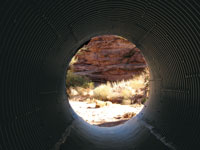 Walking through a long, dank culvert, which rattles with every step, is literally a light-at-the-end-of-the tunnel experience. After that eerie tunnel vision sensation, sunshine and soft squishy sand are a wonderful relief. Walking through a long, dank culvert, which rattles with every step, is literally a light-at-the-end-of-the tunnel experience. After that eerie tunnel vision sensation, sunshine and soft squishy sand are a wonderful relief.
Traipsing through Culvert Canyon is not a straight-line walk. Instead, it entails a lot of weaving back and forth around the many pools and thick vegetation that block the way; but the heavily used footpath will maneuver you past all these obstacles. The first overhang along the trail looks down upon a dark, mysterious pool that quenches the collective thirst of cottonwoods, oaks, junipers, rabbitbrush, desert holly and grasses. To bypass the second major pool, you need to swing right to scurry up and down a series of ledges. This portion of the path takes a little scouting to find.
Just beyond the second pool, some huge gray boulders, which have the guardian appearance of sentinels blocking your passage, are your clue that now is your chance to exit the canyon. To scope out your route from the bottom, scan the slope to your left. A pile of rocks called cairns marking the route up the short ascent will show you the way.
Once on the rim, moving in the right direction toward the arch involves some route finding. A trail that parallels the base of a very long cliff swings by a huge alcove with seeps and a hanging garden. This path does head directly north toward your goal, but has the frustrating habit of fading in and out. When you come to those long patches of slickrock, cairns are a helpful guide. Be sure to continue north by keeping a big rock buttress to your left.
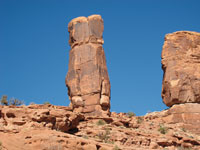 A dark rock tower next on your itinerary rises on your left, presenting you with a choice. For you can approach the south entrance of Jeep Arch by walking up and around this landmark on either side. We, however, chose an alternate, and in my opinion, an easier route that pursues a northly course by keeping the rock tower to the left. At this point continue on to the next mammoth rock mesa to pick up the well-used trail which will take you to the north entrance of the arch. A dark rock tower next on your itinerary rises on your left, presenting you with a choice. For you can approach the south entrance of Jeep Arch by walking up and around this landmark on either side. We, however, chose an alternate, and in my opinion, an easier route that pursues a northly course by keeping the rock tower to the left. At this point continue on to the next mammoth rock mesa to pick up the well-used trail which will take you to the north entrance of the arch.
On this brisk, breezy day in late October, my hiking partner and I quickly move to the south side of the arch so we can bask in the radiant sunshine that reflects off this huge semi-circle slab of sandstone. To walk around this structure in its entirety would take a good chunk of time out of your afternoon! Jeep Arch itself is dwarfed by the immense size of its base and its jagged, fractured edges make it look like the Jolly Green Giant punched out a big hole - 66-feet wide. When you’re looking at the span from just the right angle, it does present that jeep-like appearance.
Geologists believe that most of our arches were created within the last million years and have survived to this day because the Colorado Plateau is relatively free of earthquakes. The formation of an arch generally occurs at the weakened points in Wingate, Navajo and Entrada sandstone. Water dissolves the chemical cement that binds the sandstone. Then freezing expands the fractures to continue the arch making process. Once the opening is formed, it is slowly enlarged by a combination of erosion and internal stress forces. In a very few cases, the opening may be started by a rock collapse caused by the release of the internal rock strain. Wind only plays a minor part because most arches, as a general rule, are too high above the ground for abrasion from wind-borne sand to have any effect.
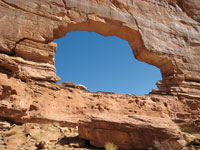 Chunks of fallen rock make it clear to me that sitting directly under Jeep Arch might be pressing my luck. When I look north through the open-air, rock-framed window, a cerulean blue sky highlights the serene looking La Sal Mountains. Walking slightly below its south-facing entrance, I am very careful to avoid getting distracted by the many photo ops. Stepping off the side into the deep abyss a few hundred feet below would be a foolish thing to do! Chunks of fallen rock make it clear to me that sitting directly under Jeep Arch might be pressing my luck. When I look north through the open-air, rock-framed window, a cerulean blue sky highlights the serene looking La Sal Mountains. Walking slightly below its south-facing entrance, I am very careful to avoid getting distracted by the many photo ops. Stepping off the side into the deep abyss a few hundred feet below would be a foolish thing to do!
It is so quiet, the southeastern views so vast, the scenery mind boggling to behold. I am peering down on a massive jumble of boulders that are strewn over elongated stretches of slickrock, which create the illusion of a gigantic jigsaw puzzle consisting of pieces that will never fit together. I take in the long distance perspective of a geological maze of pillars, mesas, slabs, fins and domes – a conglomeration of mounded, rounded, knife-edged, upended and jagged configurations rising as far as the eye can see.
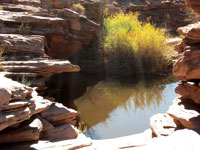 After leaving Jeep Arch, if you miss the route back down into the canyon, which is easy to do – don’t panic! Just keep moving along the rim until you get to four metal posts and some remnants of a barbed wire fence. Go through that and the old overgrown cattle trail will take you directly down to the culvert. After leaving Jeep Arch, if you miss the route back down into the canyon, which is easy to do – don’t panic! Just keep moving along the rim until you get to four metal posts and some remnants of a barbed wire fence. Go through that and the old overgrown cattle trail will take you directly down to the culvert.
If you have a shorter hike in mind, wandering to your heart’s content through Culvert Canyon until it ends at a huge pour off, is great for a pleasant, interesting excursion. Forging on to Jeep Arch is more of an adventure - a navigational challenge that is so satisfying when you do find your way to this well-known, uniquely shaped landmark.
|
Biological Soil Crust (aka)
Cryptos (krip’ tose):
The surface of
Moab’s desert is held
together by a thin skin of living organisms known as cryptobiotic
soil or cryptos. It has a lumpy black appearance, is very
fragile, and takes decades to heal when it has been damaged.
This soil is a critical part of the survival of the desert.
The cryptobiotic organisms help to stabilize the soil, hold
moisture, and provide protection for germination of the seeds
of other plants. Without it the dry areas of the west would
be much different. Although some disturbance is normal and
helps the soil to capture moisture, excessive disturbance
by hooves, bicycle tires and hiking boots has been shown
to destroy the cryptobiotic organisms and their contribution
to the soil. When you walk around Moab avoid crushing the
cryptos. Stay on trails, walk in washes, hop from stone to
stone. Whatever it takes, don’t crunch the cryptos
unless you absolutely have to! |
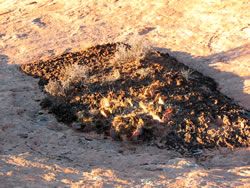
Cryptobiotic soil garden
|
|
|
 Walking through a long, dank culvert, which rattles with every step, is literally a light-at-the-end-of-the tunnel experience. After that eerie tunnel vision sensation, sunshine and soft squishy sand are a wonderful relief.
Walking through a long, dank culvert, which rattles with every step, is literally a light-at-the-end-of-the tunnel experience. After that eerie tunnel vision sensation, sunshine and soft squishy sand are a wonderful relief.  A dark rock tower next on your itinerary rises on your left, presenting you with a choice. For you can approach the south entrance of Jeep Arch by walking up and around this landmark on either side. We, however, chose an alternate, and in my opinion, an easier route that pursues a northly course by keeping the rock tower to the left. At this point continue on to the next mammoth rock mesa to pick up the well-used trail which will take you to the north entrance of the arch.
A dark rock tower next on your itinerary rises on your left, presenting you with a choice. For you can approach the south entrance of Jeep Arch by walking up and around this landmark on either side. We, however, chose an alternate, and in my opinion, an easier route that pursues a northly course by keeping the rock tower to the left. At this point continue on to the next mammoth rock mesa to pick up the well-used trail which will take you to the north entrance of the arch.  Chunks of fallen rock make it clear to me that sitting directly under Jeep Arch might be pressing my luck. When I look north through the open-air, rock-framed window, a cerulean blue sky highlights the serene looking La Sal Mountains. Walking slightly below its south-facing entrance, I am very careful to avoid getting distracted by the many photo ops. Stepping off the side into the deep abyss a few hundred feet below would be a foolish thing to do!
Chunks of fallen rock make it clear to me that sitting directly under Jeep Arch might be pressing my luck. When I look north through the open-air, rock-framed window, a cerulean blue sky highlights the serene looking La Sal Mountains. Walking slightly below its south-facing entrance, I am very careful to avoid getting distracted by the many photo ops. Stepping off the side into the deep abyss a few hundred feet below would be a foolish thing to do! After leaving Jeep Arch, if you miss the route back down into the canyon, which is easy to do – don’t panic! Just keep moving along the rim until you get to four metal posts and some remnants of a barbed wire fence. Go through that and the old overgrown cattle trail will take you directly down to the culvert.
After leaving Jeep Arch, if you miss the route back down into the canyon, which is easy to do – don’t panic! Just keep moving along the rim until you get to four metal posts and some remnants of a barbed wire fence. Go through that and the old overgrown cattle trail will take you directly down to the culvert. 